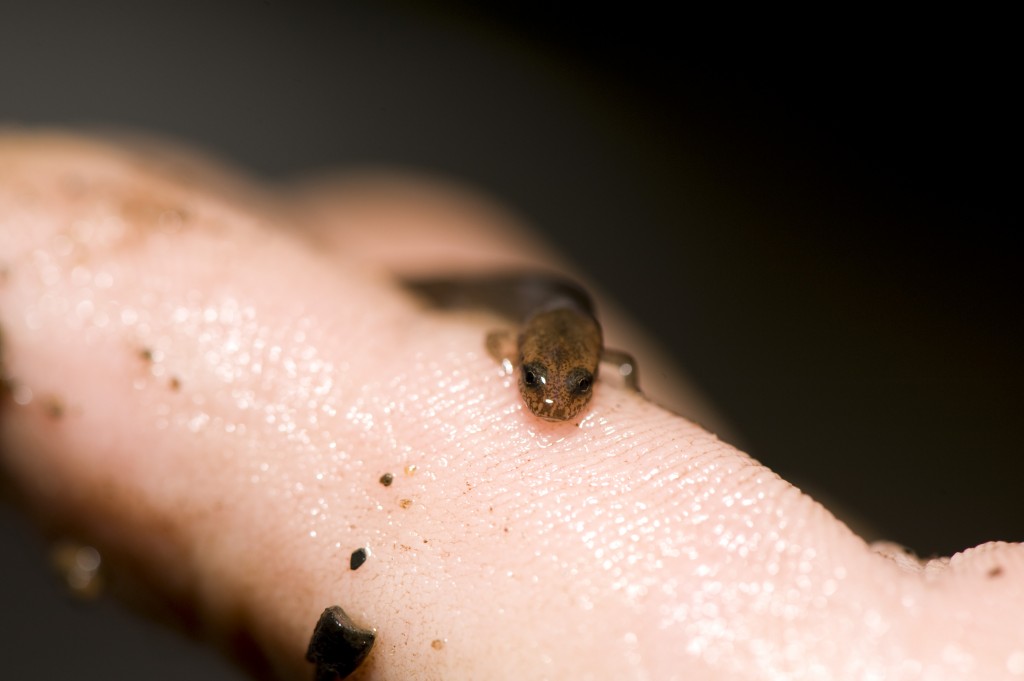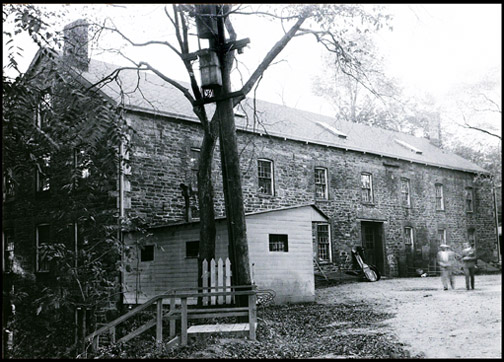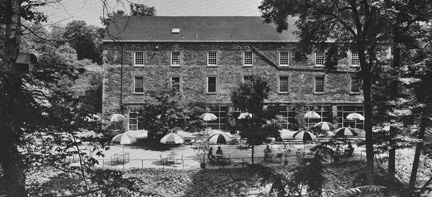Morning Eye Candy: Who Are You Lookin’ At?
Posted in Photography on November 13 2010, by Plant Talk
A Forest denizen makes a rare daytime appearance.
Barred Northern Saw-whet owl (Photo by Ivo M. Vermeulen).

Inside The New York Botanical Garden
Posted in Photography on November 13 2010, by Plant Talk
A Forest denizen makes a rare daytime appearance.
Barred Northern Saw-whet owl (Photo by Ivo M. Vermeulen).
Posted in Around the Garden, Science on November 12 2010, by Plant Talk
 The New York Botanical Garden contains not just an amazing array of flora, it is also home to an amazing diversity of fauna. There are hawks and owls, Jose the beaver, squirrels of many colors, bunnies, tiny mice, various migrating birds, and I hear tell of a duet of turkeys (though I haven’t yet seen them for myself). But it is one of the Gardens smallest animals that was our attention a few weeks ago: salamanders.
The New York Botanical Garden contains not just an amazing array of flora, it is also home to an amazing diversity of fauna. There are hawks and owls, Jose the beaver, squirrels of many colors, bunnies, tiny mice, various migrating birds, and I hear tell of a duet of turkeys (though I haven’t yet seen them for myself). But it is one of the Gardens smallest animals that was our attention a few weeks ago: salamanders.

The Garden’s native Forest is home to two distinct populations of these small amphibians: Plethodon cinereus, the terrestrial Redback Salamander and Eurycea bislineata, the aquatic Northern Two-Lined Salamander.
Learn more about what salamander can teach us about the environment below.
Posted in Exhibitions on November 12 2010, by Plant Talk
 |
Jane Dorfman was Reference Librarian/Exhibitions Coordinator in the LuEsther T. Mertz Library. |
 In recognition of the newly renovated and rededicated Lillian and Amy Goldman Stone Mill, the LuEsther T. Mertz Library has installed a display in the Rare Book and Folio Room window that details the evolution of the building.
In recognition of the newly renovated and rededicated Lillian and Amy Goldman Stone Mill, the LuEsther T. Mertz Library has installed a display in the Rare Book and Folio Room window that details the evolution of the building.
The display includes historic images of the dam and the two mills built by the Lorillards, the family who purchased the site in 1792 on the property that would become The New York Botanical Garden. The family built a major tobacco manufacturing company, one that rivaled those in Virginia. The top image pictured is circa 1936 and the other is from 1967.
 Originally built in 1840, the current structure was the third mill on the site. The mill used the Bronx River to power the waterwheels that produced tobacco and snuff. The mill was abandoned in 1870 when the company moved to New Jersey and was later purchased by the City of New York for parkland. It wasn’t until 1937 that the mill was officially transferred to the Garden.
Originally built in 1840, the current structure was the third mill on the site. The mill used the Bronx River to power the waterwheels that produced tobacco and snuff. The mill was abandoned in 1870 when the company moved to New Jersey and was later purchased by the City of New York for parkland. It wasn’t until 1937 that the mill was officially transferred to the Garden.
The display will run through January and is available for viewing during Library hours: Tuesday through Thursday, 12–6 p.m., and Friday and Saturday, 12–5 p.m.
Click here to view a video of the opening of the Stone Mill in September.
Posted in Photography on November 12 2010, by Plant Talk
How do you move a tree from point A to point B? Very carefully (and with a really big crane).
The root ball tied up (Photo by Ivo M. Vermeulen).
The Katsura tree goes up (Photo by Ivo M. Vermeulen).
Look who popped out of the root ball! (Photo by Ivo M. Vermeulen)
Posted in Photography on November 11 2010, by Plant Talk
Is it really worth two in the bush?
Chickadee (photo by Ivo M. Vermeulen).
Posted in Exhibitions, Holiday Train Show on November 10 2010, by Plant Talk
That’s sound logic, right? If you go by the decorations at the mall, its been the holidays for moths, so who even knows? In any case, we don’t want to overwhelm you before we’ve bought our turkeys yet either, but the arrival of a few truckloads of giant evergreens is always an occasion.
Earlier this week, The Garden received a special delivery of nine Abies fraseri all the way from NW North Carolina. Better known as the Frasier fir, these trees are popular choices during the holidays for their ability to retain needles long after being cut. The largest, which has been placed in the fountain by the visitor’s center measures a whopping 25 feet high. The eight other trees, which are all about 10-15 feet each, will surround the fountain as well.
Now that the trees have been placed, the next step is decorate them with approximately 400 strands of lights (that’s 20,000 bulbs!) in time for our annual tree lighting ceremony. (stay tuned for more details on that!)
Posted in Around the Garden on November 10 2010, by Plant Talk
 |
Rustin Dwyer is Visual Media Production Specialist at The New York Botanical Garden. |
The New York Botanical Garden is usually closed to the public on Mondays, but that doesn’t mean our groundskeepers and horticulturalists get the day off. Quite the opposite actually. Mondays are the days when the huge projects get done; projects that would interfere with guests enjoyment of the grounds or require large, heavy machinery.
Here’s a short video highlighting the move of a katsura tree (Cercidiphyllum japonicum) from this Monday. It was a pretty big job that required a lot of hands (especially when this little guy jumped out of the rootball!).
Enjoy!
Posted in Photography on November 10 2010, by Plant Talk
So many fascinating things happen in the Garden’s 50-acre native Forest, sometimes we forget to simply marvel at its age and beauty.
A Forest trail (photo by Ivo M. Vermeulen).
Posted in Learning Experiences on November 9 2010, by Plant Talk
| Ann Rafalko is Director of Online Content. |
I love bulbs. When we bought our house upstate a few summers ago, I couldn’t wait to see what would come up in our yard come spring. After several chilly gray months, my impatience … I mean patience, was rewarded with a dazzling display. It turns out our front garden is a perfect place for naturalizing not just daffodils, hyacinths and crocuses, but also tulips!

And so for the past two falls I have diligently supplemented the beautiful display entrusted to us by our old farm house’s previous owners. But the thing I’m realizing now is that I don’t really know how to plant bulbs. I mean, sure, I can dig a little hole and stick the bulb in (and the plantings have become much more successful now that my husband knows which end of the bulb goes up), but I don’t know anything about designing my bulb plantings. And don’t even get me started on integrating bulbs with perennials!
So it is with great anticipation that I am looking forward to a class being offered here at the Garden on Tuesday, November 23 with acclaimed landscape architect Jacqueline van der Kloet and renowned Dutch bulb expert Frans Roozen. I absolutely love the Seasonal Walk here at the Garden which was designed by Jacqueline and her collaborator Piet Oudolf (with whom she worked on Manhattan’s High Line). It is a gorgeous, long stretch of a garden that intermingles bulbs and tubers, perennials, flowering shrubs, trees, and amazing ornamental grasses. Jacqueline will offer insight into this wonderful technique while Frans will offer technical advice on planning, planting, and naturalizing bulbs.
The class is being held here at The New York Botanical Garden. It’s from 10 a.m. – 12 p.m. and costs $28 for members, $31 for non-members. You can sign-up here.
Posted in Photography, Uncategorized on November 9 2010, by Plant Talk
The Peggy Rockefeller Rose Garden is closed for the season. One last look as we say goodbye until spring.
The Rose Garden in fall (photo by Ivo M. Vermeulen).